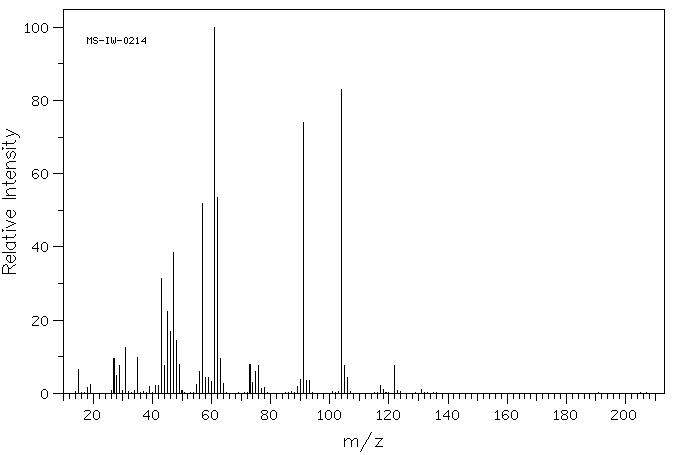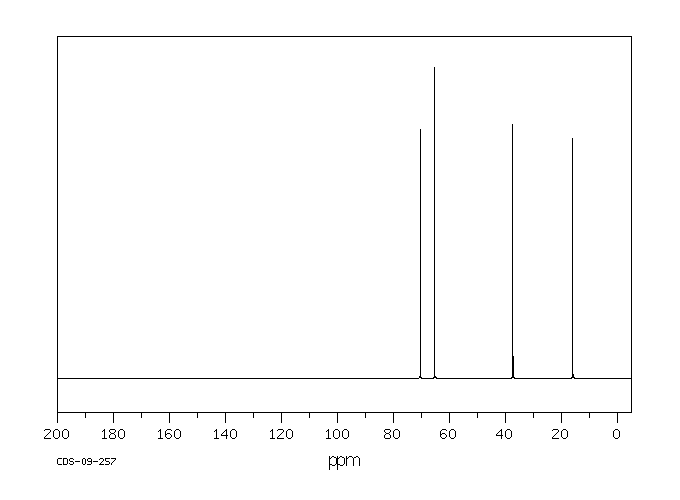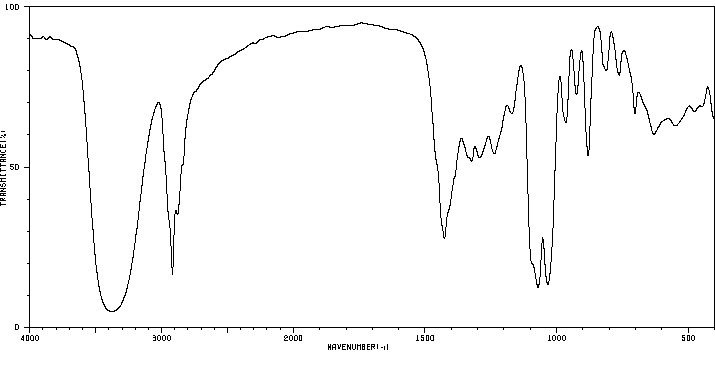3-甲基硫醇-1,2-二醇丙烷 | 22551-26-4
中文名称
3-甲基硫醇-1,2-二醇丙烷
中文别名
3-(甲基巯基)丙烷-1,2-二醇
英文名称
3-(methylthio)-1,2-propanediol
英文别名
3-methylthiopropane-1,2-diol;3-methylsulfanylpropane-1,2-diol
CAS
22551-26-4
化学式
C4H10O2S
mdl
MFCD00004724
分子量
122.188
InChiKey
FXIHXPKPLPKPJH-UHFFFAOYSA-N
BEILSTEIN
——
EINECS
——
-
物化性质
-
计算性质
-
ADMET
-
安全信息
-
SDS
-
制备方法与用途
-
上下游信息
-
文献信息
-
表征谱图
-
同类化合物
-
相关功能分类
-
相关结构分类
物化性质
-
沸点:197.63°C (rough estimate)
-
密度:1.164 g/mL at 25 °C(lit.)
-
闪点:113 °C
-
稳定性/保质期:
遵照规定使用和储存,则不会分解。
计算性质
-
辛醇/水分配系数(LogP):-0.4
-
重原子数:7
-
可旋转键数:3
-
环数:0.0
-
sp3杂化的碳原子比例:1.0
-
拓扑面积:65.8
-
氢给体数:2
-
氢受体数:3
安全信息
-
危险品标志:Xi
-
安全说明:S26,S37,S39
-
危险类别码:R36/37/38
-
海关编码:2930909090
SDS
| Name: | 3-Methylthio-1 2-propanediol 99% Material Safety Data Sheet |
| Synonym: | None |
| CAS: | 22551-26-4 |
Synonym:None
Section 2 - COMPOSITION, INFORMATION ON INGREDIENTS
| CAS# | Chemical Name | content | EINECS# |
| 22551-26-4 | 3-methylthio-1,2-propanediol | 99.0 | 245-073-1 |
Risk Phrases: None Listed.
Section 3 - HAZARDS IDENTIFICATION
EMERGENCY OVERVIEW
Not available.
Potential Health Effects
Eye:
Vapors may cause eye irritation.
Skin:
Causes skin irritation.
Ingestion:
May cause digestive tract disturbances.
Inhalation:
Vapor or mist is irritating to the mucous membranes and upper respiratory tract.
Chronic:
No information found.
Section 4 - FIRST AID MEASURES
Eyes: Flush eyes with plenty of water for at least 15 minutes, occasionally lifting the upper and lower eyelids. Get medical aid immediately.
Skin:
Get medical aid. Flush skin with plenty of water for at least 15 minutes while removing contaminated clothing and shoes. Remove contaminated clothing and shoes.
Ingestion:
If victim is conscious and alert, give 2-4 cupfuls of milk or water.
Never give anything by mouth to an unconscious person. Get medical aid immediately.
Inhalation:
Get medical aid immediately. Remove from exposure and move to fresh air immediately. If not breathing, give artificial respiration. If breathing is difficult, give oxygen.
Notes to Physician:
Treat symptomatically and supportively.
Antidote: None reported.
Section 5 - FIRE FIGHTING MEASURES
General Information:
As in any fire, wear a self-contained breathing apparatus in pressure-demand, MSHA/NIOSH (approved or equivalent), and full protective gear. During a fire, irritating and highly toxic gases may be generated by thermal decomposition or combustion.
Extinguishing Media:
Use agent most appropriate to extinguish fire.
Section 6 - ACCIDENTAL RELEASE MEASURES
General Information: Use proper personal protective equipment as indicated in Section 8.
Spills/Leaks:
Clean up spills immediately, observing precautions in the Protective Equipment section. Provide ventilation.
Section 7 - HANDLING and STORAGE
Handling:
Wash thoroughly after handling. Remove contaminated clothing and wash before reuse. Avoid contact with eyes, skin, and clothing. Avoid ingestion and inhalation.
Storage:
Store in a cool, dry place. Keep container closed when not in use.
Section 8 - EXPOSURE CONTROLS, PERSONAL PROTECTION
Engineering Controls:
Use adequate ventilation to keep airborne concentrations low.
Exposure Limits CAS# 22551-26-4: Personal Protective Equipment Eyes: Wear appropriate protective eyeglasses or chemical safety goggles as described by OSHA's eye and face protection regulations in 29 CFR 1910.133 or European Standard EN166.
Skin:
Wear appropriate protective gloves to prevent skin exposure.
Clothing:
Wear appropriate protective clothing to prevent skin exposure.
Respirators:
Follow the OSHA respirator regulations found in 29 CFR 1910.134 or European Standard EN 149. Use a NIOSH/MSHA or European Standard EN 149 approved respirator if exposure limits are exceeded or if irritation or other symptoms are experienced.
Section 9 - PHYSICAL AND CHEMICAL PROPERTIES
Physical State: Liquid
Color: colorless
Odor: Not available.
pH: Not available.
Vapor Pressure: Not available.
Viscosity: Not available.
Boiling Point: Not available.
Freezing/Melting Point: Not available.
Autoignition Temperature: Not available.
Flash Point: > 112 deg C (> 233.60 deg F)
Explosion Limits, lower: N/A
Explosion Limits, upper: N/A
Decomposition Temperature:
Solubility in water:
Specific Gravity/Density: 1.1640g/cm3
Molecular Formula: C4H10O2S
Molecular Weight: 122.18
Section 10 - STABILITY AND REACTIVITY
Chemical Stability:
Stable under normal temperatures and pressures.
Conditions to Avoid:
Incompatible materials, strong oxidants.
Incompatibilities with Other Materials:
Strong oxidizing agents, strong bases.
Hazardous Decomposition Products:
Carbon monoxide, oxides of sulfur, irritating and toxic fumes and gases, carbon dioxide.
Hazardous Polymerization: Has not been reported
Section 11 - TOXICOLOGICAL INFORMATION
RTECS#:
CAS# 22551-26-4 unlisted.
LD50/LC50:
Not available.
Carcinogenicity:
3-methylthio-1,2-propanediol - Not listed by ACGIH, IARC, or NTP.
Section 12 - ECOLOGICAL INFORMATION
Other No information available.
Section 13 - DISPOSAL CONSIDERATIONS
Dispose of in a manner consistent with federal, state, and local regulations.
Section 14 - TRANSPORT INFORMATION
IATA
Not regulated as a hazardous material.
IMO
Not regulated as a hazardous material.
RID/ADR
Not regulated as a hazardous material.
Section 15 - REGULATORY INFORMATION
European/International Regulations
European Labeling in Accordance with EC Directives
Hazard Symbols: Not available.
Risk Phrases:
Safety Phrases:
S 24/25 Avoid contact with skin and eyes.
WGK (Water Danger/Protection)
CAS# 22551-26-4: No information available.
Canada
None of the chemicals in this product are listed on the DSL/NDSL list.
CAS# 22551-26-4 is not listed on Canada's Ingredient Disclosure List.
US FEDERAL
TSCA
CAS# 22551-26-4 is not listed on the TSCA inventory.
It is for research and development use only.
SECTION 16 - ADDITIONAL INFORMATION
N/A
上下游信息
反应信息
-
作为反应物:描述:3-甲基硫醇-1,2-二醇丙烷 反应 54.0h, 以65%的产率得到(R)-3-Methylthio-1,2-propanediol参考文献:名称:Hasegawa, Junzo; Ogura, Masahiro; Tsuda, Satoru, Agricultural and Biological Chemistry, 1990, vol. 54, # 7, p. 1819 - 1827摘要:DOI:
-
作为产物:描述:参考文献:名称:BOSIES, E.;GALL, R.;WEIMANN, G.;BICKER, U.;PAHLKE, W.摘要:DOI:
文献信息
-
Glycerol kinase: substrate specificity作者:Debbie C. Crans、George M. WhitesidesDOI:10.1021/ja00310a044日期:1985.11studies indicate that glycerol kinase accepts a range of substituents in place of one terminal hydroxyl group (that which is not phosphorylated), and that the hydrogen atcm atC-2 can be replaced by a methyl group. Replacement of the second terminal hydroxyl group (that which is normally phosphorylated) by other nucleophilic centers usually results in loss of activity. Glycerol kinase is a useful catalyst甘油激酶(8.C. 2.7.1.30,ATP:甘油-3-磷酸转移酶)催化 28 个氮、硫和烷基取代的甘油的磷酸化。对 66 种类似物的调查已定性地定义了作为该酶底物可接受性的结构特征。该调查是使用基于 31P NMR 光谱的测定法进行的,该测定法检测甚至通过缓慢反应产生的产物。这些研究表明,甘油激酶接受一系列取代基来代替一个末端羟基(未磷酸化的),并且 C-2 处的氢原子可以被甲基取代。第二个末端羟基(通常被磷酸化的)被其他亲核中心取代通常会导致活性丧失。甘油激酶是合成手性有机物质的有用催化剂,尤其是制备磷脂和类似物的原料。四种微生物(念珠菌属、酵母菌、大肠杆菌和嗜热脂肪芽孢杆菌)的酶动力学常数的比较表明它们之间几乎没有变化。所有磷酸化产物都具有类似于 sn-甘油-3-磷酸酯的立体化学。
-
Galbraith, John A.; Menzel, Kent A.; Ratilla, Eva Marie A., Inorganic Chemistry, 1987, vol. 26, # 13, p. 2073 - 2078作者:Galbraith, John A.、Menzel, Kent A.、Ratilla, Eva Marie A.、Kostić, Nenad M.DOI:——日期:——
-
Efficiency of a Ruthenium Catalyst in Metathesis Reactions of Sulfur-Containing Compounds作者:Gaëlle Spagnol、Marie-Pierre Heck、Steven P. Nolan、Charles MioskowskiDOI:10.1021/ol025834w日期:2002.5.1[GRAPHICS]1,3-Dimesitylimidazol-2-ylidene ruthenium benzylidene catalyst (RuCl2(=C(H)Ph)(PCy3)(IMes)) has been successfully employed in ring-closing metathesis reactions of acyclic diene sulfides, disulfides, and dithianes and in self-cross metathesis reactions of ene-sulfides, thioethers, and thiols.
表征谱图
-
氢谱1HNMR
-
质谱MS
-
碳谱13CNMR
-
红外IR
-
拉曼Raman
-
峰位数据
-
峰位匹配
-
表征信息
同类化合物
(反式)-4-壬烯醛
(s)-2,3-二羟基丙酸甲酯
([1-(甲氧基甲基)-1H-1,2,4-三唑-5-基](苯基)甲酮)
(Z)-4-辛烯醛
(S)-氨基甲酸酯β-D-O-葡糖醛酸
(S)-3-(((2,2-二氟-1-羟基-7-(甲基磺酰基)-2,3-二氢-1H-茚满-4-基)氧基)-5-氟苄腈
(R)-氨基甲酸酯β-D-O-葡糖醛酸
(5,5-二甲基-2-(哌啶-2-基)环己烷-1,3-二酮)
(2,5-二氟苯基)-4-哌啶基-甲酮
龙胆苦苷
龙胆二糖甲乙酮氰醇(P)
龙胆二糖丙酮氰醇(P)
龙胆三糖
龙涎酮
齐罗硅酮
齐留通beta-D-葡糖苷酸
鼠李糖
黑芥子苷单钾盐
黑海棉酸钠盐
黑木金合欢素
黑曲霉三糖
黑介子苷
黄尿酸8-O-葡糖苷
麻西那霉素II
麦迪霉素
麦芽糖脎
麦芽糖基海藻糖
麦芽糖1-磷酸酯
麦芽糖
麦芽四糖醇
麦芽四糖
麦芽十糖
麦芽六糖
麦芽五糖水合物
麦芽五糖
麦芽五糖
麦芽五糖
麦芽三糖醇
麦芽三糖
麦芽三糖
麦芽三塘水合
麦芽七糖水合物
麦芽七糖
麦法朵
麦可酚酸-酰基-Β-D-葡糖苷酸
麦利查咪
麝香酮
鹤草酚
鸢尾酚酮 3-C-beta-D-吡喃葡萄糖苷
鸡矢藤苷










